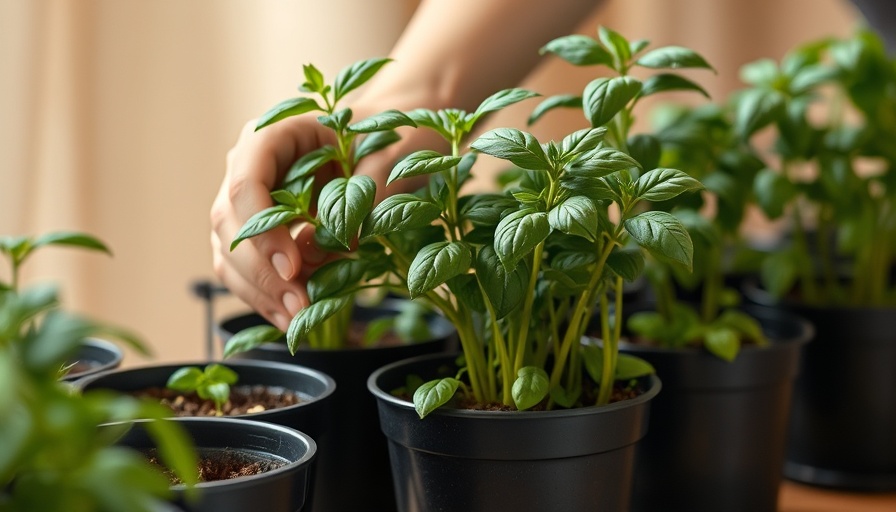
The Essential Herbs to Bring Indoors This Fall
As the temperatures drop and the crisp air of fall sets in, it's time for gardeners to prepare for the seasonal shift. While many herbs can withstand winter chill, some are frost-tender and require protection. Bringing these herbs indoors ensures a flavorful supply for the colder months ahead.
Herbs That Thrive Indoors in Winter
Among the herbs needing an indoor haven come fall are:
- Italian Genovese Basil: A staple in Italian cuisine, basil adds aromatic flavor to countless dishes. Move it inside before the first frost, ensuring it receives plenty of sunlight to thrive.
- Pineapple Sage: Known for its striking red flowers and delectable fragrance, this herb not only attracts pollinators but also brings a tropical touch to winter cooking.
- Lemongrass: Ideal for those who enjoy Asian cooking, lemongrass delivers a refreshing citrus taste and can also repel mosquitoes when outdoors.
- Cilantro: This versatile herb is essential for salsas and garnishes. Bringing it indoors allows for fresh snips just when you need them.
- Mint: The invigorating aroma of mint can enhance drinks and desserts. It’s easy to grow and maintain indoors.
- Dill: A fantastic herb for flavoring pickles and seafood, dill also adds a fresh element to salads.
Why Bringing Herbs Inside is Beneficial
Transitioning these herbs indoors not only prolongs their life but also enhances your culinary experiences. Fresh herbs can elevate the flavor profile of winter dishes, providing that homey, welcoming feel we crave during colder months. Imagine stepping outside to snip some fresh basil or cilantro for your holiday dinners!
Preparing Your Herbs for Indoor Living
When bringing your herbs inside, it's crucial to ensure they are healthy. Here are some simple steps to prepare your herbs for their new environment:
- Inspect for Pests: Check your herbs thoroughly for any pests or diseases. Treat any issues before bringing them indoors to protect your houseplants.
- Choose the Right Container: Select pots that accommodate your herbs' root systems adequately, allowing them to flourish indoors.
- Placement is Key: Position the pots by sunny windows or utilize grow lights to provide adequate light exposure throughout winter.
- Water Wisely: Reduce watering to prevent overwatering; indoor plants require less frequent hydration compared to outdoor ones.
Creating an Indoor Herb Garden: How It’s Done
Setting up your indoor herb garden can be both rewarding and visually pleasing. Here’s how to create a thriving space:
- Select a Sunny Spot: A south-facing window is ideal for maximizing sunlight exposure.
- Use Quality Soil: A good potting mix will ensure your herbs have the nutrients they need.
- Group Similar Needs: Keep herbs that have similar light and water needs together for easier maintenance.
Enhancing Your Indoor Space with Fresh Herbs
Incorporating herbs into your indoor space not only offers culinary benefits but also brings aesthetic appeal. Consider placing your herb pots on windowsills, creating a fragrant backdrop in your kitchen, and even enhancing the air quality in your home.
Local Insight: Best Practices for Muskegon Homeowners
If you are in Muskegon, be sure to prepare your backyard planting box and construct outdoor soil beds effectively to transition your plants from outdoors to indoors. For those interested in DIY landscaping, explore building elevated planter boxes or designing a utility house to store your gardening supplies. Not only does this create a more organized gardening experience, but it also enhances your overall outdoor space.
Conclusion: Start Your Indoor Herb Garden Today!
This fall, don't let your herb garden be buried under the frost. Bringing these herbs inside not only extends your gardening joy but also boosts your culinary creations. By preparing properly and setting up an indoor space, you ensure that fresh flavors are just a snip away through the winter. Embrace this opportunity to enhance your home and enjoy your gardening efforts year-round!
 Add Row
Add Row 
 Add
Add 


Write A Comment